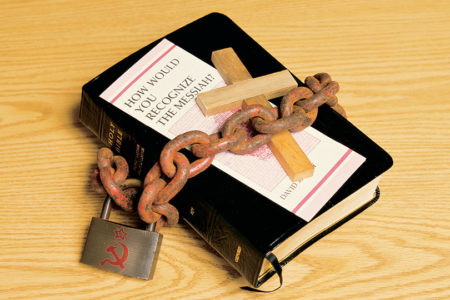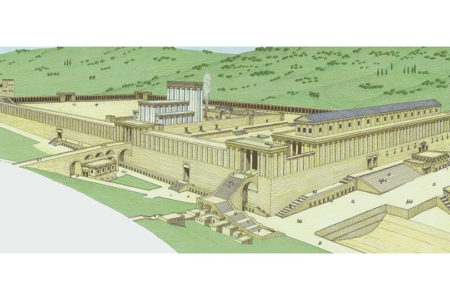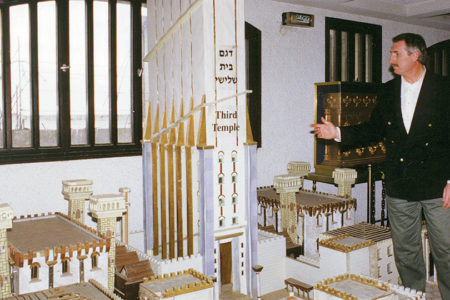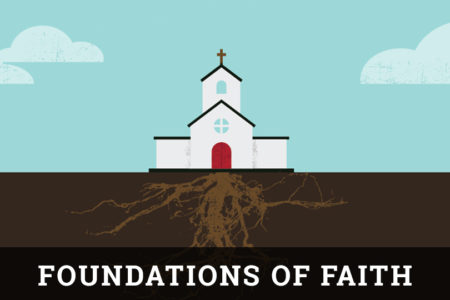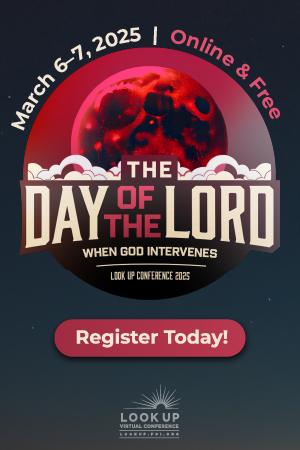Time for a Temple?
Jewish Plans to Rebuild the Temple
The most volatile 35 acres on earth are undoubtedly those comprising a rectangular platform in East Jerusalem on which the ancient Jewish Temple once stood. Both the Old Testament (Isa. 2:2–3; Ezek. 37:26–28; 40–48; Dan. 9:27; Mic. 4:1–2; Hag. 2:7–9; Zech. 6:12–15; 14:20) and the New Testament (Mt. 24:15; Mk. 13:14; 2 Th. 2:4; Rev. 11:1–2) affirm that a new Temple will once again occupy this platform as part of God’s end-time program for the nation of Israel. What evidence is there in Israel today that this predicted rebuilding is close to becoming a reality?
The Prayer for the Temple
Since the destruction of the Second Temple by the Romans in 70 A.D., Jewish prayers have been made for its rebuilding. Such a precedent was set by the Prophet Daniel while in Babylonian exile (Dan. 9:17), and Orthodox Jews—the denomination most desirous of a Third Temple—today recite three times daily the words: “May it be Thy will that the Temple be speedily rebuilt in our own time.” Even so, almost 2,000 years have passed, Israel is largely a secular state, and many people understand this thrice-recited prayer only metaphorically. Given this largely nonreligious climate, what does the modern Israeli public think of the idea of rebuilding the Temple?
In 1989, at the beginning of the Temple Movement, Time magazine reported that a 1983 newspaper poll had shown “that a surprising 18.3% of Israelis thought it was time to rebuild.”* However, since that time Israel has suffered through the Intifada, the “peace process,” and numerous riots provoked by the issue of the Temple Mount. When last year I put the question to Ehud Olmert, mayor of Jerusalem, he replied that most people were not in favor of rebuilding the Temple, believing that such an act was associated with fanatics wanting to destroy the peace process. However, on February 11, 1996, The Temple Mount and Land of Israel Faithful Movement—an Israeli activist organization that publicly demonstrates in favor of rebuilding the Temple—commissioned a poll, conducted by the international Gallup organization, of Israelis of all age groups. The question asked was: “The Temple Mount and Land of Israel Faithful Movement, headed by Gershon Salomon, put forth its main ideology on the struggle for Israeli sovereignty and the Jewish future of the Temple Mount, Jerusalem, and land of Israel, and the rebuilding of the Temple. How likely would you be to support the idea of this movement?”
The results, according to the Temple Mount Faithful, were the largest show of support any organization in Israel had ever received (58.5%). Of the polled group, the highest percentage came from young Israelis. Depending on the usual variables in statistical surveys, this indicates a substantial increase in the readiness of Israelis to see Jewish sovereignty reasserted over the Temple Mount and a new Temple erected.
The Protocol for the Temple
Orthodox Jews differ as to when and how the Third Temple should be built. One school of thought believes that the Temple cannot be built in a secular state but will descend in fire from heaven completely built after a religious government is established when the Messiah arrives in the Age of Redemption. Those who follow this belief forbid entrance to the Temple Mount on the grounds that someone might tread upon the site of the unlocated Holy of Holies, a place that has retained its sanctity despite the loss of the Temple. The predominate school of thought, however, is that the Torah obligates the Jewish nation to rebuild the Temple whenever it becomes possible to do so (Ex. 25:8). Therefore, since 1967, when access was gained to the Temple site, the nation has sinned in not obeying this divine command. They argue that no Temple was ever built without human preparation (1 Ki. 5–6; Ezra 3:7–11), and that this effort had divine approval (1 Chr. 22:14; 23:4).
Based on rabbinic authority, they contend that even though heaven must send the Prophet and the Messiah as a sign of redemption, this will not be done until there is national repentance and a desire to begin the task of rebuilding (see Yalkut Shimoni Samuel 106). Therefore, they say, since 1967, when Israel acquired sovereignty over the Temple site, Israel has continually experienced national problems because it has failed to rebuild. When the Palestinian Intifada began in 1987, various Jewish groups who held this ideology felt they could wait no longer and began to work in different ways to prepare for the day when the Temple could be rebuilt. Thus was born the Temple Movement with its research and activist wings striving separately, but with a united goal.
The Place for the Temple
In order to build the Temple, it is believed that the exact location of the former two Temples must be correctly identified. One reason for this is that it is argued that the site for the Temple was divinely appointed (Gen. 22:2; Ex. 15:17; 2 Sam. 24:18; 1 Chr. 21:18).
Another reason is that there also appears to be a continuity between Temples—each being built with its Holy of Holies enclosing the same protrusion of Mount Moriah known as Even ha-Shetiyah (The Foundation Stone). Because it was upon this stone that the Ark of the Covenant had been set and the Shekinah (Divine Presence) had descended (1 Ki. 8), departed (Ezek. 8:4; 11:23), and promised to return (Ezek. 43:1–7), it is thought that no other place can be substituted. The problem has been in locating this place. The Temple Mount platform, built to support the Temple and its courts, has been preserved down through the centuries. While this has limited the area for the search, it is impossible to resolve the matter due to the lack of access to the site for archaeological confirmation. Nevertheless, based on many evidences that can be discerned without archaeological investigation, three major theories of location have been advanced.
One theory put forth by Tel Aviv architect Tuvia Sagiv, based on accounts in ancient sources and topographical elevations, argues that the Temple was situated at the southwestern corner of the platform near to where the Al Aqsa mosque is today.* He also suggests from surveys of this area—employing ground-penetrating radar probes and infrared thermographic scans—that traces of underground structures may prove the presence of vaults and that Hadrian’s Roman temple to Jupiter once stood in this southern region. If this Roman temple was built over the destroyed Jewish Temple, as was often the custom, this may indicate that the Temple was originally at this location.
A more popular theory is that of Hebrew University physicist Asher Kaufmann.* His research—relying upon details given in the Mishna tractate known as Middot (Measurements), computations of angles of line-of-sight between the Mount of Olives where the red heifer was sacrificed, and the eastern court of the Temple where the Great Altar stood, as well as physical clues discovered around the outside of the platform that are now destroyed or hidden by the Muslims—concludes that the Temple was built on the northwestern corner of the platform only about 330 feet from the Muslim Dome of the Rock. He believes that the bedrock identifiable within a small cupola at this site, known in Arabic as the Dome of the Tablets, was the Foundation Stone within the Holy of Holies.
Another theory, with both traditional support and the consensus of Israeli archaeologists, is that the Temple stood exactly where the Dome of the Rock is today. Early research by Benjamin Mazar, the Israeli archaeologist who directed the excavations adjacent to the Temple Mount, and recent research by Leen Ritmeyer, who served as chief architect for the excavations, have produced diagrams of the locations of both the First and Second Temples, based on physical evidence remaining at the site.* Ritmeyer has done extensive study of the rock within the Muslim Dome of the Rock and concluded that not only is it the Foundation Stone, but that foundation trenches and the walls of the Holy of Holies, and even the place where the Ark of the Covenant rested, are still discernible.* Most of the Orthodox Jews presently preparing for a Temple have agreed upon this latter location. Once access to the site is gained for archaeological excavation, answers will be quickly forthcoming.
The Plans for the Temple
According to Temple Institute spokesman Rabbi Chaim Richman, detailed blueprints for the Third Temple have existed for the past four years. The plans were necessarily drawn according to the primary sources for this information: the Bible, Josephus, and Middot. Additions to these ancient specifications have included the use of electricity and other modern improvements that agree with Halacha (the Law).
Other structures pertaining to the Temple’s function have also been planned or actually built. Under the auspices of Rabbi Shlomo Goren, the 70-seat Supreme Court building that housed the Sanhedrin in Temple times has again been constructed. According to Goren, its present location adjacent to the Temple Mount is correct for the restored Temple complex as envisioned by the Prophet Ezekiel, which is to be 30 times larger than that of previous Temples.* The legal stipulations that the Sanhedrin will use to govern Israel’s relationship to the rebuilt Temple and its services have already been researched and are in the process of being published (the first volume in 1986) by the Research Center for Jewish Thought under the direction of Yoel Lerner.
The Preparations for the Temple
Since 1987, a group of rabbinical researchers, designers, and craftsmen, under the direction of Rabbi Yisrael Ariel, have been creating in the Jewish Quarter of Jerusalem what they call a “Temple-in-waiting.”* Their efforts have resulted in computerized visualizations and blueprints for the Third Temple and the production of ritually qualified vessels, garments, and other items necessary for a restoration of the Temple services. Known as the Temple Institute, this organization has been at the forefront of the publication of Third Temple research. Among the items that have been or are in the process of being created are: apparel for the high priest (his eight-layered woven robe, the golden crown worn on his head, and his jeweled breastplate bearing the names of the tribes of Israel); priestly garments and the blue-purple dye (tchelet) for the priestly tsitsit (fringes on the prayer shawl); the eleven sacrificial incense spices, urns, ewers, incense pans, forks, shovels, and carts (for burnt offerings); the gold and silver mizrak (vessels used to dispense sacrificial blood on the altar); the golden laver, flasks, and measuring cups (used in the libation offerings); vessels for the meal offerings; the lottery boxes (for the Day of Atonement); the mortal and pestle and the stone vessel (kelal) for grinding and holding the purifying ashes of the red heifer; the golden menorah (lampstand); cleaving instruments and oil pitchers for replenishing the oil for its light; silver trumpets (for assembling Israel at the Temple); and the barley altar.
While a replica of the Ark of the Covenant is prominently displayed in the Temple Institute’s visitor center, spokesmen for the Institute publicly state that they believe the original still exists in a secret chamber located under the Temple Mount beneath the site of the Holy of Holies. When access to the site is possible and all other ritual requirements have been met, they expect it to be recovered and take its place within the restored Temple.*
The Priests for the Temple
According to rabbinic tradition, even though the genealogical records of the Temple were lost and Jews were scattered throughout Gentile lands, those of the tribe of Levi were forbidden to alter their names (which connoted their priestly heritage) when assimilated into foreign cultures. Thus, we continue to this day to have Levis and Cohens and derivatives of those names. Recently, a more scientific test to verify those of priestly lineage has appeared. In studies of male Jews claiming descent from Aaron, it was found that they as a group uniquely carry an aberration of the Y chromosome. Because each person’s DNA is as individual as a fingerprint, this characteristic linked these men together as a separate and identifiable group that must be traced back to an original ancestor.
However, even without such information to identify priests, Rabbi Nachman Kahane, head of the Young Israel Synagogue (the closest synagogue to the Western Wall, located in the Muslim Quarter) and The Institute for Talmudic Commentaries maintain a computerized list of all known candidates in Israel. Other Orthodox organizations in Israel are helping to educate this priesthood. The Yeshiva founded by Motti Dan Hacohen, known as Ateret Cohanim, trains its students in the order of priestly service. The yeshiva states that it is not interested in activist attempts to enter the sacred precincts, but, with its sister organization Atara Leyoshna, it has aggressively attempted to acquire numerous Arab properties in the Muslim Quarter next to the Temple Mount in order to establish a “Jewish presence” in preparation for rebuilding the Temple.
The Purification for the Temple
According to the rabbis of the Temple Movement, in order for a Temple to be rebuilt today, those who would enter the area of sanctity and perform the holy tasks must first be ritually pure. Because all Jews have become ceremonially unclean in the Diaspora (Dispersion), the only means to reverse this condition and establish a functioning priesthood is through the ashes of the red heifer (described in Num. 19).
This year, a red heifer was born in Israel—the first in 2,000 years.* There is some debate concerning its legitimacy due to the presence of several white hairs. Nevertheless, other qualified red heifers have been secured from Mississippi rancher Clyde Lott. These have already been approved by Israeli authorities for import and are now awaiting transport to Israel.* Because the Jewish sage Maimonides taught that there had been nine red heifers between the beginning of the Tabernacle and the end of the Second Temple, and that when the tenth arrived it would be prepared by the Messianic King,* a special urgency is attached to this recovery by leaders of the Temple Institute, such as Rabbi Chaim Richman.*
The Politics of the Temple
The issue of rebuilding the Temple has been at the forefront of the Arab-Israeli conflict, though often downplayed. The Islamic Authority (called in Arabic the Wakf), which maintains rigid control of the Temple Mount, blamed the Israeli government for starting a fire in the Al Aqsa mosque in 1969 in order to destroy the structure and rebuild the Temple, despite the fact that a mentally unstable member of a Christian cult actually set the blaze.
Ever since, the Muslims have assumed that every incursion in or near the area—whether for archaeological or religious purposes—has been for the same purpose. For this reason, riots followed: an excavation to uncover the subterranean Western Wall tunnel in 1982, a demonstration by the Temple Mount Faithful in 1990 in which 17 were killed, excavations to reveal the Herodian street next to the Western Wall in 1995, and the opening of an exit tunnel to the Hasmonean tunnel in 1996, in which 58 were killed. In March 1997, Yasser Arafat was shown in a photograph—distributed internationally by the Associated Press—holding up an artist’s rendering of a restored Jewish Temple and telling his people to “get ready for the next battle” (for Jerusalem). Similar calls for conflict were also issued from loudspeakers on the Temple Mount to Arabs in East Jerusalem during each of the preceding riots.
Religious Access to the Temple Mount
Since 1967, when the Israeli government returned jurisdiction of the Islamic holy places on the Temple Mount to the Wakf, Jews (and Christians) have been forbidden under Islamic law to enter the area for religious purposes. However, the law protecting the holy places adopted by the Knesset on June 27, 1967, had as one of its provisions: “Whoever does anything that is likely to violate the freedom of access of the members of the various religions to the places sacred to them or their feelings with regard to those places shall be liable to imprisonment…” This included Jews who above all regarded the Temple Mount with utmost reverence and had just fought to recover it.
Nevertheless, after 30 years in a united Jerusalem with the Temple Mount under Israeli sovereignty, Jews still are not permitted access to the site of the Temple for prayers or religious acts of any kind. Last year, however, the Israeli Supreme Court finally issued a ruling upholding the right of Jews to pray on the site. In a letter from Benjamin Netanyahu to Yehuda Etzion, the activist whose trial for resisting arrest, when forcibly removed from the Temple Mount after attempting to pray, resulted in the court ruling, the Prime Minister stated: “The right of the Jewish people to its holy place—the Temple Mount—cannot be questioned. I believe it is necessary to arrange for Jewish prayer at the site, especially given that we permit freedom of worship to all religions in Jerusalem…”*
If access to the site of the Temple is soon permitted for religious purposes, many services long suspended since the Temple’s destruction will be reinstituted. Such actions, it has been argued, would further demand a rebuilt Temple to complete and focus these acts of devotion (see Ezra 3:2–3). For this reason, Gershon Salomon’s Temple Mount Faithful have attempted to offer a Passover sacrifice near the site of the ancient altar, which they believe to be the Dome of the Rock. Salomon states why his organization believes this sacrifice is so important: “Major rabbis during the time after the destruction of the Temple, especially Rabbi Tucochinsky in Jerusalem in the 1930s, stated that the first Passover sacrifice which will be made on the Temple Mount will bring about the coming of Mashiach ben David and the rebuilding of the Temple.” Although denied access to the Mount for this purpose, last Passover (April 8), members of the group cut the Omer Hatnofah (first wheat harvest) from Israeli fields and symbolically offered it as firstfruits on a makeshift Temple altar. Members carried small stones from their fields and deposited them on the pavement of the Temple Mount. In addition, during the annual Feast of Tabernacles, the group conducts a restored water libation ceremony (originally performed when the Temple was standing) at the Pool of Siloam. Along with this, they regularly attempt to lay a cornerstone, which they have made for the Third Temple on the Temple Mount, and don chains and sackcloth and march to the site every year on Tisha B’Av (the time of mourning the destruction of the Second Temple).
The Perspective for the Temple?
The modern physical preparations and political demonstrations by Orthodox Jews point toward the ultimate fulfillment of a restored Jewish Temple. The first of these will be rebuilt to occupy a prominent role in the period known as “the time of Jacob’s Trouble” (Jer. 30:7), or the Tribulation (Dan. 9:27; Mt. 24:15; Mk. 13:14; 2 Th. 2:4; Rev. 11:1–2). The last of these will be designated as the Messiah’s Temple and will appear in the Millennial Kingdom (Isa. 2:2–3; 66:23; Ezek. 37:26–28; 40–48; Mic. 4:1–2; Hag. 2:7–9; Zech. 6:12–15; 14:2, 16–21).
These Temples will play an important role in the future prophetic program for Israel and the Gentile nations (Isa. 56:6–7; Jer. 3:17; Zech. 6:15). For believers in this age of the church who are awaiting the Rapture—an event that will occur before the Tribulation commences with the signing of the covenant of Daniel 9:27—these present efforts to rebuild represent a significant sign of events that will be part of the Tribulation. As such, readiness to rebuild announces the nearness of this coming day and encourages us as believers to live godly and productive lives as we watch and wait for the “blessed hope” (Rom. 13:11–14; 1 Th. 1:10; 5:5–11; Ti. 2:13).

